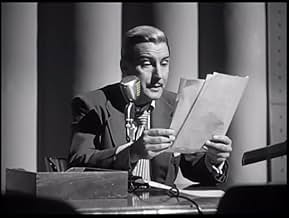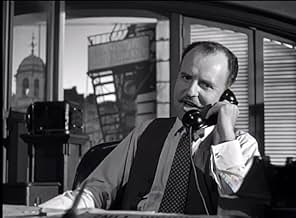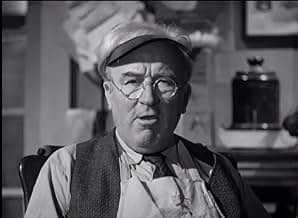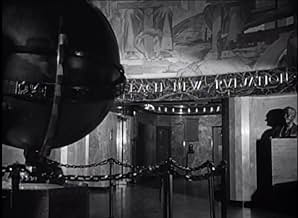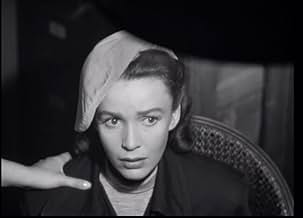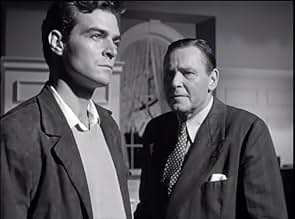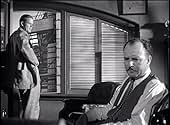Ajouter une intrigue dans votre langueThe story of the fight of a small-town newspaper to free an innocent girl of a murder charge, with the publisher of a metropolitan city newspaper heading, by forced circumstances, the opposi... Tout lireThe story of the fight of a small-town newspaper to free an innocent girl of a murder charge, with the publisher of a metropolitan city newspaper heading, by forced circumstances, the opposing forces.The story of the fight of a small-town newspaper to free an innocent girl of a murder charge, with the publisher of a metropolitan city newspaper heading, by forced circumstances, the opposing forces.
- Réalisation
- Scénario
- Casting principal
- Carl Durham
- (as Howard da Silva)
- Munsey's Assistant
- (non crédité)
Avis à la une
Not to ignore any social issues that the film might have intended to address, but you're really spinning yer' wheels over very little if you spend too much time looking for them. True, the innocent black maid is framed for murder (and, indeed, Gar Moore's despicable character even utters the "N" word), but it strikes me as just another compelling element in this very intense drama (and if they wanted to make a big social point, why didn't they hire an actual black actress for the part, I wonder?)
Dan Duryea was born to play the role of Mike Reese; he totally dominates the film, and brilliantly. Gale Storm is pretty and has a nice, simple charm about her, but she's totally out of her league alongside Duryea, Herbert Marshall, Howard da Sylva, and Michael O'Shea.
Speaking of da Sylva's role, several other reviewers have cited his "scenery chewing"; I disagree, and strongly. DaSylva, a first-rate actor, is a model of control: suave, witty, affable...a facade which barely manages to conceal a razor-sharp hostility just beneath the surface. It's a masterful, if fairly brief, performance.
Also, it's fascinating to watch "Underworld Story" and discover why the classic "Night of the Hunter" (1955) looks the way it does. Stanley Cortez's bleak, stylized cinematography adds immensely to the atmosphere of "Underworld", especially the near-expressionistic look of the streets and buildings of the town where most of the action takes place.
"Underworld Story" should be regarded as a stand-out example of classic, late 40-s noir.
Big-city reporter Dan Duryea finds himself in a jam that makes him persona non grata to his newspaper, the district attorney's office and underworld boss Howard Da Silva. Broke and blacklisted, he buys himself a partial stake in a struggling community paper, The Lakewood Gazette, owned by Gale Storm, who's put off by his brash ways and temporizing ethics. But a headline story breaks right there in the idyllic New England town: The daughter-in-law of press baron Herbert Marshall has been murdered, and Duryea seizes the chance to run with the scoop.
It's not a whodunit, though; the killer, it's clear from the outset, is Marshall's snivelling son (Gar Moore, who sounds like HAL the computer). But when the murdered woman's black maid (Mary Anderson) goes missing, Marshall sees opportunity to whip up public sentiment against her. Storm, who knew the maid, trusts in her innocence; Duryea, on the other hand, waits to see which outcome might profit him most. When The Gazette starts a defense fund for Anderson, Marshall and his son start running scared and seek a favor from Da Silva to put a stop to the tenacious Duryea, who's been won over by Storm....
The Underworld Story's a modest movie that's well put together (it looks great, too, photographed by Stanley Cortez, who also shot The Magnificent Ambersons and Night of the Hunter). But it belongs to Duryea, who could play affable but slithery better than anybody, and his twists and turns keep us guessing.
Reminiscent of 30s socially-conscious cinema more than film noir, The Underworld Story also shows that decade's story-telling verve. It's been purged of preaching, so when one character remarks `Looks like they're burning witches again,' we suddenly recall that its release came in the midst of the Hollywood anti-Communist witch hunt, and that at least two of its principals director Cy Endfield and Da Silva were among its victims.
For its time, the movie's about as cynical as they come. Still, this crime drama's a genuine sleeper with few punches pulled until the Code enforced ending that unfortunately isn't very convincing. What the story does show in fairly unsparing style is how corruption can reach into a town's highest levels. The narrative is pretty plot heavy so you may need the proverbial scorecard. But it's an intelligent screenplay, providing plausible motivation for the various misdeeds.
I suspect the movie's title comes from the role the underworld plays in doing the dirty work for more respectable members of society, and then exploiting the connection for nefarious purposes (Stanton & Durham). It's the connection between the two worlds that appears to be the main theme. DeSilva plays the mob boss in unusually jovial fashion (perhaps too much), along with occasional hints of snarling menace.
I wouldn't expect a cheerleader type like Gale Storm to be in a crime movie, but she does a believable job as the struggling suburban publisher, put into a fix by her recently deceased dad. I kept expecting something to develop between her and the high-powered Reese, but this is not a movie of clichés.
As I recall, the film was taken to task for casting a white woman (Anderson) in the important role of the "Negro" maid Molly. Now, there's a question of why the maid would be made a Black woman in the first place since her race is not a factor in plot development. And second, why cast an obvious white woman in the part, which only invites unneeded curiosity. I'm not sure what the answers are, but leftist writer Blankfort and director Endfield may have wanted to make a racial statement that didn't make it to the screen. But whatever the reason, the casting remains a false note in an otherwise thoughtful screenplay.
Several notable social themes do emerge. Note how easily a well-meaning public is fleeced by Reese and the shyster lawyer, after offering up their hard earned money to the defense committee. Then there's the town's wealthy establishment that can ruin anyone who crosses them, including Reese and his newspaper. Or the yellow journalism that will print whatever promises to make money. Just as importantly, these key topics play out in fairly subtle, non-preaching fashion.
Director Endfield shows here, as in his powerful Sound of Fury, aka Try and Get Me (1950), that given the chance away from his Joe Palooka programmers, he could do social conscience films with the best of them. Note the many careful touches in this film—the shabby people lined up to donate to the defense committee, the defining bust of Napoleon discretely behind editor Lee's (Dunne) desk, Lee slyly opening the door behind Reese despite what he's saying. Too bad Endfield finished his career in England after falling victim to the blacklist.
All in all, the movie's not as powerful as Sound of Fury, but it does avoid clichés and remains consistently engaging and unpredictable. Endfield appears fascinated in both films with yellow journalism and how it's used to exploit society, a worthy topic for any period. Editor Reese is nothing if not entrepreneurial in his schemes, with the money-making ideas spitting out as fast as a machine gun. It's an impressive lead performance by the great Duryea. Anyway, except for the occasionally cheap sets and unconvincing climax, this obscure indie production remains a genuine sleeper.
It carries the Warner Bros. patina - a gritty crime melodrama with a mix of social commentary and thick-ear rough stuff, and with a curious collection of supporting characters. Howard Da Silva, Gale Storm, Michael O'Shea and Harry Shannon all do themselves credit and Herbert Marshall(?) also manages to fit in.
This is a good semi-noir. It starts off as one but switches in mid-picture to straight drama and then back again. Only 90" long, it holds your interest throughout. It may not sound promising but sometimes you can't judge a movie by its title.
Le saviez-vous
- AnecdotesThe "N" word is overdubbed with "Negro" on at least two occasions. [Note: this may be a local station's practice; the version shown on TCM contains the uncensored language.]
- GaffesAt the funeral, there is a headstone marked "Robert Elis 1720-1777". After the service, as the mourners are leaving, the same headstone appears in a completely different place.
- Citations
District Attorney Ralph Munsey: Take it easy, Reese. Things are tough all over. Pretty soon a man won't be able to sell his own mother.
- Versions alternativesThe manufacture-on-demand DVD from Warner Archive Collection has the opening and closing 1992 Warner Bros. Pictures logos.
- ConnexionsReferences Le chant de Bernadette (1943)
Meilleurs choix
- How long is The Underworld Story?Alimenté par Alexa
Détails
- Date de sortie
- Pays d’origine
- Langue
- Aussi connu sous le nom de
- The Underworld Story
- Lieux de tournage
- Los Angeles City Hall - 200 North Spring Street, Downtown, Los Angeles, Californie, États-Unis("The Turk" was murdered on the steps of City Hall)
- Société de production
- Voir plus de crédits d'entreprise sur IMDbPro
- Durée
- 1h 31min(91 min)
- Couleur
- Rapport de forme
- 1.37 : 1

